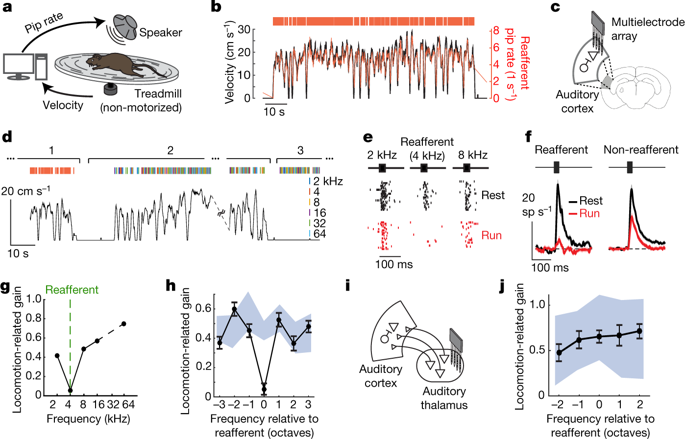Our official English website, www.x-mol.net, welcomes your feedback! (Note: you will need to create a separate account there.)
A cortical filter that learns to suppress the acoustic consequences of movement
Nature ( IF 64.8 ) Pub Date : 2018-09-01 , DOI: 10.1038/s41586-018-0520-5 David M Schneider 1, 2 , Janani Sundararajan 1 , Richard Mooney 1
Nature ( IF 64.8 ) Pub Date : 2018-09-01 , DOI: 10.1038/s41586-018-0520-5 David M Schneider 1, 2 , Janani Sundararajan 1 , Richard Mooney 1
Affiliation

|
Sounds can arise from the environment and also predictably from many of our own movements, such as vocalizing, walking, or playing music. The capacity to anticipate these movement-related (reafferent) sounds and distinguish them from environmental sounds is essential for normal hearing1,2, but the neural circuits that learn to anticipate the often arbitrary and changeable sounds that result from our movements remain largely unknown. Here we developed an acoustic virtual reality (aVR) system in which a mouse learned to associate a novel sound with its locomotor movements, allowing us to identify the neural circuit mechanisms that learn to suppress reafferent sounds and to probe the behavioural consequences of this predictable sensorimotor experience. We found that aVR experience gradually and selectively suppressed auditory cortical responses to the reafferent frequency, in part by strengthening motor cortical activation of auditory cortical inhibitory neurons that respond to the reafferent tone. This plasticity is behaviourally adaptive, as aVR-experienced mice showed an enhanced ability to detect non-reafferent tones during movement. Together, these findings describe a dynamic sensory filter that involves motor cortical inputs to the auditory cortex that can be shaped by experience to selectively suppress the predictable acoustic consequences of movement.Training of mice to associate a particular sound frequency with locomotion results in selective suppression of cortical responses to that frequency during movement, consistent with a motor-dependent form of auditory cortical plasticity.
中文翻译:

一种学习抑制运动的声学后果的皮质过滤器
声音可能来自环境,也可能来自我们自己的许多动作,例如发声、走路或演奏音乐。预测这些与运动相关的(重新传入的)声音并将它们与环境声音区分开来的能力对于正常听力至关重要 1,2,但学习预测由我们的运动产生的经常随意和多变的声音的神经回路在很大程度上仍然未知。在这里,我们开发了一个声学虚拟现实 (aVR) 系统,在该系统中,老鼠学会了将新声音与其运动运动联系起来,使我们能够识别学习抑制再传入声音的神经回路机制,并探索这种可预测的感觉运动的行为后果经验。我们发现,aVR 体验逐渐和选择性地抑制听觉皮层对再传入频率的反应,部分是通过加强对再传入音调有反应的听觉皮层抑制神经元的运动皮层激活。这种可塑性在行为上具有适应性,因为体验过 aVR 的小鼠在运动过程中表现出增强的检测非传入音调的能力。总之,这些发现描述了一种动态感觉过滤器,它涉及到听觉皮层的运动皮层输入,可以通过经验来塑造,以选择性地抑制运动的可预测的声学后果。训练小鼠将特定的声音频率与运动相关联导致选择性抑制皮层在运动过程中对该频率的反应,与依赖于运动的听觉皮层可塑性形式一致。
更新日期:2018-09-01
中文翻译:

一种学习抑制运动的声学后果的皮质过滤器
声音可能来自环境,也可能来自我们自己的许多动作,例如发声、走路或演奏音乐。预测这些与运动相关的(重新传入的)声音并将它们与环境声音区分开来的能力对于正常听力至关重要 1,2,但学习预测由我们的运动产生的经常随意和多变的声音的神经回路在很大程度上仍然未知。在这里,我们开发了一个声学虚拟现实 (aVR) 系统,在该系统中,老鼠学会了将新声音与其运动运动联系起来,使我们能够识别学习抑制再传入声音的神经回路机制,并探索这种可预测的感觉运动的行为后果经验。我们发现,aVR 体验逐渐和选择性地抑制听觉皮层对再传入频率的反应,部分是通过加强对再传入音调有反应的听觉皮层抑制神经元的运动皮层激活。这种可塑性在行为上具有适应性,因为体验过 aVR 的小鼠在运动过程中表现出增强的检测非传入音调的能力。总之,这些发现描述了一种动态感觉过滤器,它涉及到听觉皮层的运动皮层输入,可以通过经验来塑造,以选择性地抑制运动的可预测的声学后果。训练小鼠将特定的声音频率与运动相关联导致选择性抑制皮层在运动过程中对该频率的反应,与依赖于运动的听觉皮层可塑性形式一致。



























 京公网安备 11010802027423号
京公网安备 11010802027423号